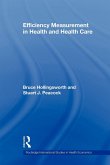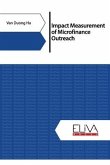- Broschiertes Buch
- Merkliste
- Auf die Merkliste
- Bewerten Bewerten
- Teilen
- Produkt teilen
- Produkterinnerung
- Produkterinnerung
Provides a comprehensive approach to productivity and efficiency analysis using economic and econometric theory.
Andere Kunden interessierten sich auch für
![Efficiency Measurement in Health and Health Care Efficiency Measurement in Health and Health Care]() Bruce HollingsworthEfficiency Measurement in Health and Health Care60,99 €
Bruce HollingsworthEfficiency Measurement in Health and Health Care60,99 €![Price and Productivity Measurement Price and Productivity Measurement]() W. Erwin DiewertPrice and Productivity Measurement16,99 €
W. Erwin DiewertPrice and Productivity Measurement16,99 €![The Measurement of Financial Risk and Evaluation of Economic Policy Based on Big Data The Measurement of Financial Risk and Evaluation of Economic Policy Based on Big Data]() Heng-Guo ZhangThe Measurement of Financial Risk and Evaluation of Economic Policy Based on Big Data50,99 €
Heng-Guo ZhangThe Measurement of Financial Risk and Evaluation of Economic Policy Based on Big Data50,99 €![Analytic System for the Measurement of Relative Fire Hazard (Mercantile Classes) Analytic System for the Measurement of Relative Fire Hazard (Mercantile Classes)]() Albert Flandreau DeanAnalytic System for the Measurement of Relative Fire Hazard (Mercantile Classes)22,99 €
Albert Flandreau DeanAnalytic System for the Measurement of Relative Fire Hazard (Mercantile Classes)22,99 €![Impact Measurement of Microfinance Outreach Impact Measurement of Microfinance Outreach]() van Duong HaImpact Measurement of Microfinance Outreach41,99 €
van Duong HaImpact Measurement of Microfinance Outreach41,99 €![Performance Measurement in Philanthropic Foundations Performance Measurement in Philanthropic Foundations]() Helmut AnheierPerformance Measurement in Philanthropic Foundations52,99 €
Helmut AnheierPerformance Measurement in Philanthropic Foundations52,99 €![101 Proven Ways to Increase Efficiency and Make More Money in Lawn Care 101 Proven Ways to Increase Efficiency and Make More Money in Lawn Care]() Paul Jamison101 Proven Ways to Increase Efficiency and Make More Money in Lawn Care14,99 €
Paul Jamison101 Proven Ways to Increase Efficiency and Make More Money in Lawn Care14,99 €-
-
-
Provides a comprehensive approach to productivity and efficiency analysis using economic and econometric theory.
Produktdetails
- Produktdetails
- Verlag: Cambridge University Press
- Seitenzahl: 626
- Erscheinungstermin: 28. März 2019
- Englisch
- Abmessung: 227mm x 154mm x 40mm
- Gewicht: 883g
- ISBN-13: 9781107687653
- ISBN-10: 1107687659
- Artikelnr.: 54427029
- Herstellerkennzeichnung
- Libri GmbH
- Europaallee 1
- 36244 Bad Hersfeld
- gpsr@libri.de
- Verlag: Cambridge University Press
- Seitenzahl: 626
- Erscheinungstermin: 28. März 2019
- Englisch
- Abmessung: 227mm x 154mm x 40mm
- Gewicht: 883g
- ISBN-13: 9781107687653
- ISBN-10: 1107687659
- Artikelnr.: 54427029
- Herstellerkennzeichnung
- Libri GmbH
- Europaallee 1
- 36244 Bad Hersfeld
- gpsr@libri.de
Robin C. Sickles is the Reginald Henry Hargrove Professor of Economics and Professor of Statistics at Rice University, Houston. He served as Editor-in-Chief of the Journal of Productivity Analysis as well as an Associate Editor for a number of other economics and econometrics journals. He is currently an Associate Editor of the Journal of Econometrics.
Preface
Introduction
1. Production theory: primal approach
2. Production theory: dual approach
3. Efficiency measurement
4. Productivity indexes: part 1
5. Aggregation
6. Functional forms
7. Productivity indexes: part 2
8. Envelopment-type estimators
9. Statistical analysis for DEA and FDH: Part 1
10. Statistical analysis for DEA and FDH: part 2
11. Cross-sectional stochastic frontiers
12. SF models-first generation panel approaches
13. SF models-second generation approaches
14. Endogeneity
15. Dynamic models
16. Shape restrictions and model averaging
17. Measurement, KLEMS, and other data
Afterword.
Introduction
1. Production theory: primal approach
2. Production theory: dual approach
3. Efficiency measurement
4. Productivity indexes: part 1
5. Aggregation
6. Functional forms
7. Productivity indexes: part 2
8. Envelopment-type estimators
9. Statistical analysis for DEA and FDH: Part 1
10. Statistical analysis for DEA and FDH: part 2
11. Cross-sectional stochastic frontiers
12. SF models-first generation panel approaches
13. SF models-second generation approaches
14. Endogeneity
15. Dynamic models
16. Shape restrictions and model averaging
17. Measurement, KLEMS, and other data
Afterword.
Preface
Introduction
1. Production theory: primal approach
2. Production theory: dual approach
3. Efficiency measurement
4. Productivity indexes: part 1
5. Aggregation
6. Functional forms
7. Productivity indexes: part 2
8. Envelopment-type estimators
9. Statistical analysis for DEA and FDH: Part 1
10. Statistical analysis for DEA and FDH: part 2
11. Cross-sectional stochastic frontiers
12. SF models-first generation panel approaches
13. SF models-second generation approaches
14. Endogeneity
15. Dynamic models
16. Shape restrictions and model averaging
17. Measurement, KLEMS, and other data
Afterword.
Introduction
1. Production theory: primal approach
2. Production theory: dual approach
3. Efficiency measurement
4. Productivity indexes: part 1
5. Aggregation
6. Functional forms
7. Productivity indexes: part 2
8. Envelopment-type estimators
9. Statistical analysis for DEA and FDH: Part 1
10. Statistical analysis for DEA and FDH: part 2
11. Cross-sectional stochastic frontiers
12. SF models-first generation panel approaches
13. SF models-second generation approaches
14. Endogeneity
15. Dynamic models
16. Shape restrictions and model averaging
17. Measurement, KLEMS, and other data
Afterword.








